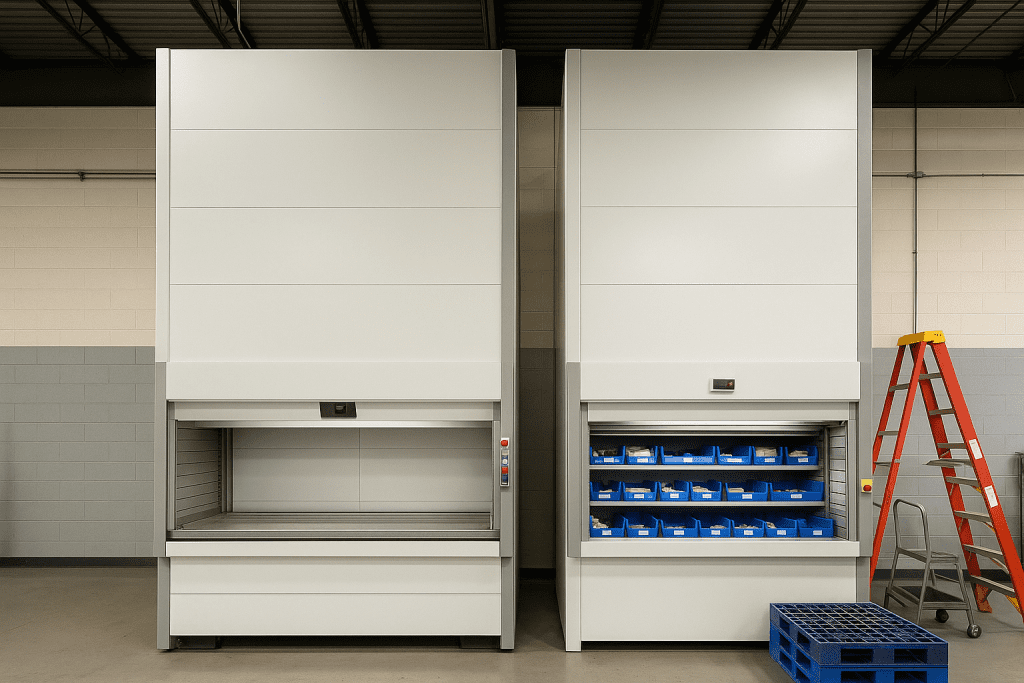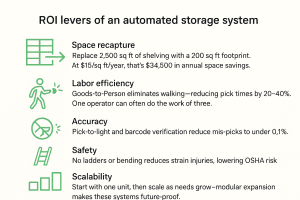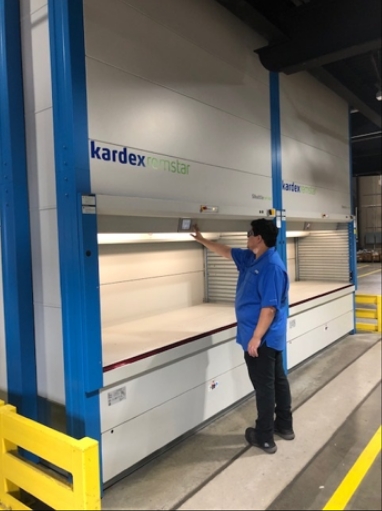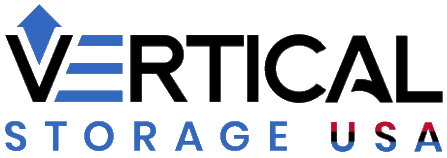Decision-makers comparing warehouse automation often come down to two dominant technologies: Vertical Lift Modules (VLMs) and Vertical Carousels (VCs). Both reclaim valuable floor space, improve picking efficiency, and increase accuracy—but they excel in different ways.
This guide explores how each system works, what they cost (new and used), efficiency comparisons, industry-specific use cases, and how to select the right automated storage system for your facility.
Quick definitions
Vertical Lift Module (VLM)
A VLM is a tall, enclosed cabinet with two columns of trays and a central extractor. When an operator requests an item, the system measures tray height and delivers it to an ergonomic access window.
Examples: Modula VLM (ML/MX/MC series), Kardex Shuttle XP.
Learn more: Vertical Lift ModulesVertical Carousel (VC)
A vertical carousel is a series of rotating shelves, operating like a Ferris wheel. The requested shelf rotates into position and stops at an ergonomic access point.
Examples: Kardex Megamat RS, Hänel Rotomat, White Systems vertical carousel.
Learn more: Vertical Carousels
Both are classified as automated storage systems (AS/RS), designed to increase cubic density and deliver goods-to-person access.
Cost ranges (new vs. used) and what drives them
The first question most managers ask: “What does an automated storage system cost?” The answer depends on system type, configuration, and add-ons.
New systems
VLMs: $85,000 – $250,000+ per unit
Height: A 12-foot VLM will cost significantly less than a 40-foot tower.
Tray size: Wider and deeper trays increase cost.
Load capacity: Heavy-duty trays rated for thousands of pounds cost more.
Software: Basic inventory software is often included, but ERP/WMS integrations can add $20K–$40K.
Options: Dual delivery, refrigeration, or fire suppression push the price up.
Get details: Vertical Lift Module Price Guide
Vertical Carousels: $60,000 – $180,000+ per unit
Shelf pitch: Carousels use fixed shelf spacing; more specialized spacing increases price.
Machine height: Taller units cost more in materials and installation.
Pick technology: Adding pick-to-light, barcode scanning, or RFID boosts price.
Explore: Warehouse Carousel Systems
Used equipment
A used vertical storage carousel or pre-owned VLM often costs 40–60% of new.
Add relocation, reconfiguration, and new software licensing into total cost.
Example: A $120,000 new carousel may resell for ~65,000, but relocation and install could add another $15,000.
Efficiency & performance comparison
| Category | VLM (e.g., Modula VLM, Kardex Shuttle XP) | Vertical Carousel (e.g., Kardex Megamat RS, Hänel Rotomat) |
|---|---|---|
| Throughput | High with dual delivery & batch picking; intelligent sequencing reduces downtime. | Steady throughput, but longer rotations add wait time. |
| Space savings | Up to ~90% vs. shelving via auto tray-height optimization. | Excellent cube utilization, though shelf pitch limits flexibility. |
| Ergonomics | Always delivers trays to waist height. | Also ergonomic—shelves present at waist level. |
| SKU variability | Ideal for mixed sizes and irregular shapes. | Best for uniform SKUs in bins/totes. |
| Payload | Heavy-duty trays up to 2,000+ lbs. | Strong payloads, but check model specs. |
| Speed to pick | Very fast with pre-positioning logic. | Fast when items are near; slower on full rotations. |
| Ceiling height use | Excellent for tall facilities (up to 46 ft). | Practical in medium ceiling spaces (up to ~30 ft). |
| Software | Advanced: slotting, batch picking, audit logs, integration. | Reliable controllers with WMS/ERP compatibility. |
Key takeaway: Both are powerful automated storage systems, but VLMs adapt better to variable SKUs, while carousels excel in uniform small-parts environments.
Best use cases with industry examples
When a VLM automated storage system is best
Electronics distribution: thousands of SKUs with unpredictable dimensions.
Medical device manufacturing: strict lot/serial traceability.
Aerospace MRO: high-value tools and components that need controlled access.
Defense & government: compliance-heavy environments where audit trails matter.
Tall warehouses: maximize vertical cube where ceilings exceed 20 feet.
When a Vertical Carousel automated storage system is best
Automotive parts: uniform bins of fasteners, gaskets, and small components.
Healthcare facilities: pharmacies or hospitals storing uniform kits and devices.
Service counters: dealerships or parts counters with predictable demand.
Lower ceiling warehouses: buildings capped under ~20–25 feet.
Budget-conscious upgrades: easier entry cost for automation.
New vs. used: how to decide
Timeline: Need equipment fast? Used carousels are often available sooner.
SKU fit: Ensure trays (VLMs) or shelves (carousels) match your part sizes.
Total landed cost: Add relocation, reconditioning, new controls, and warranties.
Critical uptime: For mission-critical lines, a new automated storage system with service contract reduces risk.
Explore: Used Vertical Carousels • Used Vertical Lift Modules
ROI levers of an automated storage system
Space recapture
Replace 2,500 sq ft of shelving with a 200 sq ft footprint. At $15/sq ft/year, that’s $34,500 in annual space savings.Labor efficiency
Goods-to-Person eliminates walking—reducing pick times by 20–40%. One operator can often do the work of three.Accuracy
Pick-to-light and barcode verification reduce mis-picks to under 0.1%.Safety
No ladders or bending reduces strain injuries, lowering OSHA risk.Scalability
Start with one unit, then scale as needs grow—modular expansion makes these systems future-proof.
Facility & implementation checklist
Ceiling height & slab strength: confirm specs against manufacturer cut sheets.
Fire code: may require sprinklers or smoke detection for tall systems.
Electrical & data: dedicated circuits, UPS protection, and network cabling.
Material flow: plan staging areas for inbound/outbound carts.
Operator training: build SOPs for replenishment, cycle counts, and audits.
Maintenance planning: preventive maintenance contracts protect uptime.
Change management: communicate benefits early to gain staff buy-in.
Pros & cons at a glance
VLM Automated Storage System
Pros: Maximum density, handles variable SKUs, batch picking boosts throughput, scalable for tall warehouses.
Cons: Higher upfront cost, more complex mechanics, requires strong vendor support.
Vertical Carousel Automated Storage System
Pros: Lower entry cost, simple motion, reliable for uniform parts, fast access for service counters.
Cons: Less flexible with mixed SKUs, slower rotation cycles at taller heights.
Final take
If your facility needs to handle high SKU variability, strict traceability, or maximum space density, a VLM automated storage system is the stronger option.
If your operation requires steady, repeatable access to uniform parts at a lower investment, a vertical carousel automated storage system is the perfect fit.
Both deliver strong ROI when paired with the right software, training, and service plan.
Next steps:
Compare costs: Vertical Lift Module Price Guide
Explore systems: Vertical Lift Modules • Vertical Carousels
Consider pre-owned: Used Equipment & Systems




